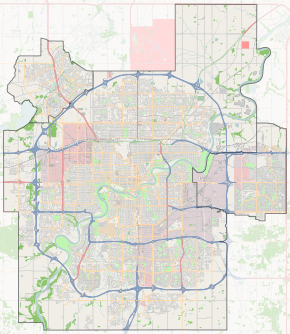Sakaw, Edmonton
| Sakaw | |
|---|---|
| Neighbourhood | |
 Sakaw Location of Sakaw in Edmonton | |
| Coordinates: 53°26′28″N 113°25′37″W / 53.441°N 113.427°W | |
| Country |
|
| Province |
|
| City | Edmonton |
| Quadrant[1] | NW |
| Ward[1] | 11 |
| Sector[2] | Southeast |
| Area[3][4] Community |
Mill Woods Millhurst |
| Government[5] | |
| • Administrative body | Edmonton City Council |
| • Councillor | Mike Nickel |
| Area[6] | |
| • Total | 1.11 km2 (0.43 sq mi) |
| Elevation | 701 m (2,300 ft) |
| Population (2012)[7] | |
| • Total | 4,113 |
| • Density | 3,705.4/km2 (9,597/sq mi) |
| • Change (2009–12) |
|
| • Dwellings | 1,408 |
Sakaw is a residential neighbourhood located in the Mill Woods area of south Edmonton, Alberta, Canada. It is a part of the Mill Woods community of Millhurst. The name means "wooded area" in the Cree language."[8]
Residential construction in the neighbourhood occurred during the 1970s and 1980s. Just under half (44.7%) of the residences in the neighbourhood were built between 1971 and 1980. Another 46.2% were built between 1981 and 1990. Almost all of the remaining residences were built after 1990.[9]
According to the 2005 municipal census, single-family dwellings account for seven out of ten (70%) of the residences in the neighbourhood. Row houses account for another one out of every six (16%) and duplexes[10] account for one in twelve (8%) of residences. One in twenty (5%) of residences are Rented apartments in low-rise buildings with fewer than seven stories. Three out of four (75%) of residences are owner-occupied while the remaining one in four (25%) are rented.[11]
There is one school in the neighbourhood, Sakaw Elementary School, operated by the [Edmonton Public Schools|Edmonton Public School System.]
The neighbourhood is bounded on the west by 66 Street, the north by Mill Woods South road the east by 50 Street, and by the South by the Anthony Henday Drive.
Demographics
In the City of Edmonton's 2012 municipal census, Sakaw had a population of 4,113 living in 1,408 dwellings,[7] a -1.9% change from its 2009 population of 4,194.[12] With a land area of 1.11 km2 (0.43 sq mi), it had a population density of 3,705.4 people/km2 in 2012.[6][7]
Surrounding neighbourhoods
 |
Ekota | Meyokumin | Pollard Meadows |  |
| Menisa | |
Crawford Plains | ||
| ||||
| | ||||
| Anthony Henday Drive, Ellerslie | Anthony Henday Drive, Charlesworth | Anthony Henday Drive |
References
- 1 2 "City of Edmonton Wards & Standard Neighbourhoods" (PDF). City of Edmonton. Retrieved February 13, 2013.
- ↑ "Edmonton Developing and Planned Neighbourhoods, 2011" (PDF). City of Edmonton. Retrieved February 13, 2013.
- ↑ "The Way We Grow: Municipal Development Plan Bylaw 15100" (PDF). City of Edmonton. 2010-05-26. Retrieved February 13, 2013.
- ↑ "City of Edmonton Plans in Effect" (PDF). City of Edmonton. November 2011. Retrieved February 13, 2013.
- ↑ "City Councillors". City of Edmonton. Retrieved February 16, 2014.
- 1 2 "Neighbourhoods (data plus kml file)". City of Edmonton. Retrieved February 13, 2013.
- 1 2 3 "Municipal Census Results – Edmonton 2012 Census". City of Edmonton. Retrieved February 22, 2013.
- ↑ From the neighbourhood description in the City of Edmonton map utility.
- ↑ http://censusdocs.edmonton.ca/DD23/FEDERAL%202001/Neighbourhood/SAKAW.pdf
- ↑ Includes triplexes and quadruplexes.
- ↑ http://censusdocs.edmonton.ca/C05002/MUNICIPAL%202005/Neighbourhood/SAKAW.pdf
- ↑ "2009 Municipal Census Results". City of Edmonton. Retrieved February 22, 2013.